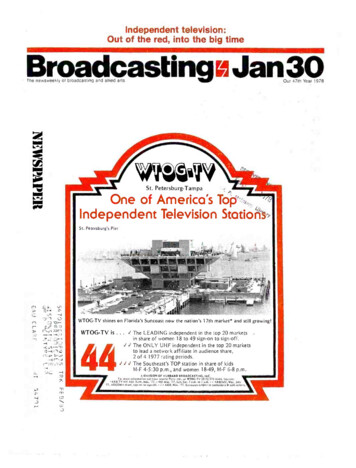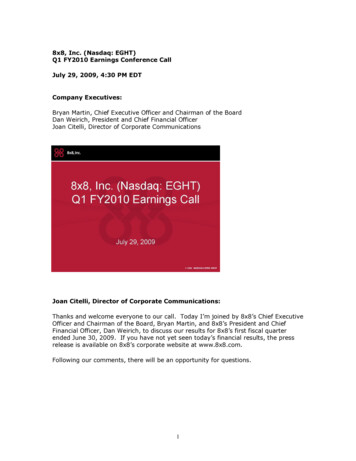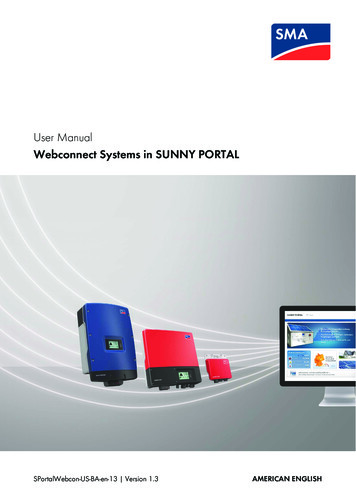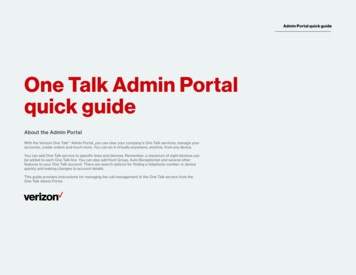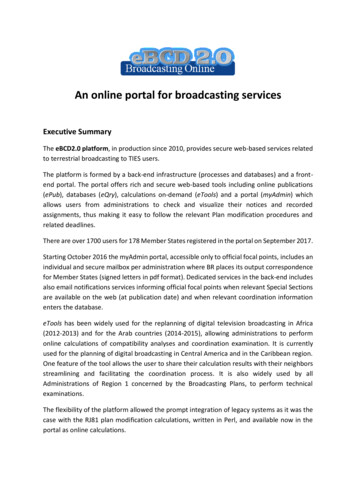
Transcription
An online portal for broadcasting servicesExecutive SummaryThe eBCD2.0 platform, in production since 2010, provides secure web-based services relatedto terrestrial broadcasting to TIES users.The platform is formed by a back-end infrastructure (processes and databases) and a frontend portal. The portal offers rich and secure web-based tools including online publications(ePub), databases (eQry), calculations on-demand (eTools) and a portal (myAdmin) whichallows users from administrations to check and visualize their notices and recordedassignments, thus making it easy to follow the relevant Plan modification procedures andrelated deadlines.There are over 1700 users for 178 Member States registered in the portal on September 2017.Starting October 2016 the myAdmin portal, accessible only to official focal points, includes anindividual and secure mailbox per administration where BR places its output correspondencefor Member States (signed letters in pdf format). Dedicated services in the back-end includesalso email notifications services informing official focal points when relevant Special Sectionsare available on the web (at publication date) and when relevant coordination informationenters the database.eTools has been widely used for the replanning of digital television broadcasting in Africa(2012-2013) and for the Arab countries (2014-2015), allowing administrations to performonline calculations of compatibility analyses and coordination examination. It is currentlyused for the planning of digital broadcasting in Central America and in the Caribbean region.One feature of the tool allows the user to share their calculation results with their neighborsstreamlining and facilitating the coordination process. It is also widely used by allAdministrations of Region 1 concerned by the Broadcasting Plans, to perform technicalexaminations.The flexibility of the platform allowed the prompt integration of legacy systems as it was thecase with the RJ81 plan modification calculations, written in Perl, and available now in theportal as online calculations.
The goal of eBCD2.0 has always been to streamline working processes, improve efficiency, becloser to administrations providing information as soon as possible and minimize the need forprinted documents in line with the green ITU concept.The possibility of testing the notice submission files before officially submitting it to the BRvia WISFAT gives the possibility of streamlining the whole process, making easier thecoordination process which implies a reduction of the workload on both the BR andadministrations and a reduction of the time needed for notices to be recorded in the plan.During the plan modification procedures, BCD needs to communicate with Member States. Inmany letters reference is made to information available in the portal, and we intend to movemore and more towards a paperless office.The Online Validation application allows administrations to validate their notice prior toWISFAT submission, streamlining the all process and reducing the workload on both BR andadministrations, has been developed reusing many features from eTools. The eMIFRapplication has also been developed followingThe eBCD2.0 platform was implemented using the latest technologies (web applications, AJAX,GIS internet servers, distributed computing systems). Following the BR pilot project in CloudComputing, cloud resources could now be seamlessly integrated with the infrastructure onpremises in case more computing power is needed.A recent survey (see Annex 1) conducted in December 2016 shows that around 75% of theusers consult the online tools at least a few times a week, consider that the onlinefunctionalities satisfy their requirements and that the lay-out and the presentation on thetools are clear and easy to use. The survey participants suggested also functionalities to beimplemented in the portal and the BR would work in implementing them as soon as possible.Following the state-of-the-art technology, we plan to redesign the web front-end using thelightweight ASP.NET MVC technology, and to integrate all the applications for terrestrialservices in a single web portal.
Description of the eBCD 2.0 portalFour main features are available from this portal, as depicted in Figure 1.Figure 1:main features of eBCD 2.0eQryThe basic feature eQry allows fast online searches on broadcasting Plans. It provides thepossibility of performing queries on a read-only copy of the BR database, updated daily.Searches can be performed on a limited number of fields including administration, geographicarea, assigned frequency, administration unique identifier, BR identification number, site orallotment name and the status (recorded/published).The advantage to display a quasi-live database as we do in eQry and in myAdmin (a read-onlycopy from live database is performed each night) is to allow administrations to consult theirnotices and to find the latest information reflected promptly such as the Status and thecoordination information. On the latter, for example, the coordination information isavailable as soon as it is captured, without the need for administration to wait for the deliveryof the next BR IFIC.ePubePub displays the broadcasting publications online. The advantage over traditional deliveryvia BR IFIC is the possibility for the user to consult the Special Sections at publication date. Anextract is performed on the BR database in such a way to build up a static database containing
only relevant records. All broadcasting publications since 2007 are available from ePub andpromptly consultable.ePub allows searching by BR IFIC number and by Administration, both for its own notificationsand for notifications affecting itself.eToolseTools offers calculation on-demand in the scope of the GE06, GE84 and RJ81 agreements fortesting purposes. In addition, it offers the possibility of performing propagation predictioncalculations according to the recommendations ITU-R P.1812 and P.1546. The latest additionconcern the compatibility analyses calculation for region 2. Detailed descriptions of thecalculations available are listed in Annex 2.The BR is planning to add more and more calculations type, both for plan modificationprocedures (GE75 Art.4 calculations, GE06 Conformity Art. 5 examination) and forpropagation prediction models.The possibility of running the coordination or conformity examinations of the noticesubmission files before officially submitting it to the BR via WISFAT give the possibility ofstreamlining the whole process, reducing the workload on both the BR and administrationsand reducing the time needed for notices to be recorded in the plan.This online tool in fact offers the possibility following advantages:1) Even if the use of BRIFIC software tools for validations is strongly encouraged, an“unofficial” online validation allows the user to verify that the notice file is correct. Ifthis is not the case, the portal gives the reasons for the problem allowing the user tofix the problem and submit the file again, without engaging in time consuming e-mailor phone call exchange with the BR. This procedure allows also a learning process forthe user.2) The calculation of coordination contours allows the user to determine whichadministrations are considered to be potentially affected by the new notices.3) The user can then engage in coordination process with those administrations, aimingto get the agreement before officially submitting the notice to the BR via WISFAT. Tothis purpose, eTools offers the possibility to share calculation results with users of anyadministrations.4) eTools offers also the possibility to perform more detailed calculations with thepropagation prediction modules (i.e. ITU-R P.1812), allowing to take into account alsoterrain data in the coordination process, or using the compatibility analysis tool.5) When all the agreements have been obtained the users can submit the notice file withthe request of publication in part B, which greatly speed up the recording process (40days instead of at least 75 days).
The process of submission of calculation request is depicted in Figure 2.The back-end infrastructure performing the calculations is completely decoupled from theweb portal and is currently composed by more than 20 independent calculation services tomanage the workload. ITU has recently performed a pilot-project to integrate cloudcomputing resources to the infrastructure on-premises, which would allow us to easily scalethe system up when needed (see Annex 2).Figure 2: Process of submission of calculation request via eTools
myAdminmyAdmin allows an administration to visualize their notices and recorded assignment andnotices from other administration affecting it in a way which make it easy to follow the planmodification procedures and related deadlines.The following components are available:myMailBox: where the BR posts private communications for a given Member State.1) Outgoing BR letters sent by fax and posted simultaneously on the portal.2) Other type of communications, including the following
Plans and MIFR dashboard: where for any given plan it is displayed the statistics for thefollowing data and the possibility to browse to the details of the notices/assignments underconsiderations:PlansMIFR Recorded assignments;Notices published in Part 1;Notices published in Part 2;Notices published in Part 3;
Description of the eBCD 2.0 platform architectureThe front-end tools described above display data from different database, which arepopulated at the back-end from different processes. The layout of the architecture isdepicted in the figure below.The E-mail notification services sends email to focal points in the following cases when new Special Sections containing his/her notifications/notifications affectinghim/her are available on the web
when Coordination information for his/her notices enters the database
eBCD2.0 StatisticsThe number of users registered in the portal is given in Figure 3, while the statisticsconcerning the number of daily login and the distributions of users and Member Statesaccording to ITU regions is displayed in Figure 4.Figure 3: number of registered users and focal point per administrationIt can be seen as 178 Member States (over 193 BR Member States) have at least oneregistered user in the portal, for a total of 1726 users on 14 September 2017. Concerningthe focal points, it is worth to mention that administrations have been notified in October2016 of the restricted access to myAdmin portal. On September 2017 there are 191registered focal points from 73 administrations.
Figure 4: Number of daily logins in 2017 (left) and statistics of registered users and Member Statesfor ITU regions (right)Description of the usage of eBCD2.0 for the correspondencefrom BCD to Member States:GE84 PlanIn the BR outgoing letter to administrations concerned by modification of coordinationinformation for the GE84 Plan the following sentences are added: “Coordination data havebeen entered into BR database and can be verified by WEB application myAdmin on thefollowing link (TIES login tPages/myAdministration.aspx “)
1. For WISFAT submission:”Before submitting TB3 notices via WISFAT, you are invited to check coordination data byWEB application myAdmin on the following link (TIES login tPages/myAdministration.aspx “)GE06 PlaneBCD2.0 is used and mentioned in some GE06 correspondence that concern long list ofproposed modifications.Future plans forecast the usage of eBCD2.0 for all type of correspondence, relating to thepublication and Plan procedures:-The day of publication: inform affected administrations;The reminders to the administrations that did not send their decision or comments(depends on the relating Agreement);Inform the notifying administrations when objections are received;Returned request of publication in part B (missing agreements)To streamline working processes, improve efficiency, be closer to administrations providinginformation as soon as possible and minimize the need for printed documents in line withthe green ITU concept we intend to provide on the long run all correspondence via eBCD2.0
Description of the technology behind eBCD2.0Authentication and authorizationTIES authentication is used for eQry, ePub and eTools. For myAdmin, in addition, there is anextra layer of authorization which the Broadcasting Service Division implements in order tomake sure that the TIES user logged in belongs to an organization which is authorized by theMember State to act in its behalf.The back-end distributed infrastructureAs a component of our IT system, we have developed a local distributed infrastructurewhich is currently used to manage the workload of calculations-on-demand submitted byour Membership. Such a workload is greatly time-dependent.The current ITU distributed client-server system is based on the pull model, with a databaseacting as the master and a number of Windows services as the slaves. Users submit calculationrequests via a web portal which stores the input data in the database as pending job requests.The calculation services wake up periodically to check if there are new jobs to be run, executethem, manage the jobs status and notify the user at job completion.The system is implemented in C#. The calculation modules, called by the Windows services,can be implemented in different languages (FORTRAN, C, C , COBOL). The databasecontaining the tables for managing the jobs (and storing input data and output results) is SQLServer.The web portal permits the user to control the job (submit/cancel) and also to monitor itsstatus (pending, running, completed, failed).The calculation modules may be CPU and data demanding. For one business case(propagation prediction calculation) for example, the input data for any given job mayconsist of up to one hundred files (3MB each in size), identified at run-time out of a totaldataset of 15 thousands files (total size of the dataset: 45 GB).Cloud computing pilot-projectThe BR has performed a pilot-project aimed to extend this distributed infrastructure to enableus to explore the potential of Cloud Computing, with the main goal to study the easiness ofdeploying software and data and of performing calculations on the cloud, with particularemphasis on scalability and security issues.The BR would be in a position to seamlessly integrated cloud resources with the infrastructureon-premises in case more computing power is needed.
Annex 1: eBCD2.0 SurveyThe data was collected in the period 7 December – 16 January 2017 with the questionnaire displayedin Figure 5. In this period 283 users consulted eBCD2.0 and 113 users from 73 Member Statesanswered the survey (40% response rate).Figure 5: Survey questions
The survey results in Figure 6 shows that around 75% of the users consult the online tools atleast a few times a week, consider that the online functionalities satisfy their requirementsand that the lay-out and the presentation on the tools are clear and easy to useFigure 6: Survey results
Annex 2: on-demand calculations for testing and coordination purposesusing eToolsGE06D Article 4 Plan modification (Coordination and ConformityExamination)Modification of a Plan entryThe coordination examination is carried out in accordance with procedures specified inSection 1 of Annex 4 of GE06 Regional Agreement.The result identifies the potentially affected administrations with which you need to seekagreement.You can then start coordination activities in order to obtain all the necessary agreementsbefore officially notifying the notices to the BR via WISFAT, streamlining the overall processand reducing the time needed for recording into the Plan.When coordinating with affected administrations you may want to perform a more precisepropagation assessment by submitting a P1812 calculation, as the coordination examinationkeeps into account terrain data only via the effective antenna height.Input: e-notice file (to be previously validated using TerRaNotices)Output: coordination contours displayed on a GIS map (see Figure 7)
Figure 7:Coordination contours according to the GE06 agreementAddition of (an) assignment(s) stemming from an existing allotment entry inthe PlanThe conformity examination is carried out in accordance with procedures specified inSection 2 of Annex 4 of GE06 Regional Agreement.The result indicates whether the proposed stemming assignment(s) is (are) in conformityhence can enter the Plan without coordination or not in conformity, hence to be returned tothe notifying administration.In case for some test points the implementation field strength exceed the envelop fieldstrength you can tune your technical parameters in order to try to reduce the field strengthin the identified azimuths. You can then submit again the modified notice file forcalculations and check if you succeeded in bringing the implementation field strength belowthe limits of the envelope.Testing that your converted assignments are in conformity with the plan entry beforeofficially notifying the notices to the BR via WISFAT streamlines the overall process andreduces the time needed for recording into the Plan.Input: e-notice file (to be previously validated using TerRaNotices)Output: Geometrical and BC cut-off field strength contours on a GIS map (see Figure 8)
Figure 8:Geometrical and BC cut-off field strength contour for theconformity examinationeTOOLS: on-demand calculations for testing and coordination purposesPropagation prediction calculations using Recommendations ITU-R P.1812This Recommendation describes a propagation prediction method suitable for terrestrialpoint-to-area services in the frequency range 30 MHz to 3 GHz and for distances in therange between 0.25 km and 3000 km. It predicts signal levels exceeded for a givenpercentage of time, p%, in the range 1% p 50% and a given percentage of locations, pL, inthe range 1% pL 99%.This method may be used to predict both the service area and availability for a desiredsignal level (coverage), and the reductions in this service area and availability due toundesired, co- and/or adjacent-channel signals (interference).Input Data: The user submits a calculation request by filling a form in the web portal specifyingthe technical parameters needed for the propagation assessment. Both point to point(profile) and point to area (coverage) calculations can be performed. The input data requiredfor the Point to Point calculation is shown in Figure 9, while the input data required for thePoint to Point calculation is shown in Figure 10.
Figure 9: Point to Point (profile) input dataFigure 10: Point to Area (coverage) input dataThe calculation currently uses the SRTM3 terrain databases (3arc-sec resolution); thepossibility of using higher resolution DEM is under investigation.Output ResultsThe output of the Point to Area calculation consists in a coverage contour, displaying thecontour where a wanted FS (which is an input variable) is exceeded. The points of thecoverage are also available in a tabular format which include the following information(Azimuth, Longitude, Latitude, Effective Radius, Terrain Height (m), Distance (km) and Fs (dBμV/m).This calculation can be a useful tool during coordination activities, as can be seen consideringthe example below.Figure 11 below shows the coordination contour for a station in Torino (Italy) using themethod outlined for the plan modification procedure in the Article 4 of the GE06 agreement.This method is a conservative approach which takes into consideration the terraininformation only via the effective antenna height, defined in most cases (see Annex 2.1 ofChapter 2 to Annex 2 in the GE06 agreement) as the height on the antenna over the averagelevel of the ground between the distances of 3 and 15 km from the transmitter. This methoddoes not clearly take into account the effect of the mountains around Torino. Figure 12 showsthe coverage contour calculated with the recommendation ITU-R P.1812: the effect of themountains is clearly visible.
Figure 11: Coordination Contour accordingto an Article 4 calculation for a station inTorino. The effect of the terrain is takeninto account only via the effective antennaheight.Figure 12: Point to Area calculation for thesame station as Figure 11: the coveragecontour is clearly smallerA Google Earth display (see Figure 13) is also available for visualization of the terraincharacteristics.Figure 13: Google Earth display of the contourshown in Figure 12The output of the Point to Point calculation (see Figure 14) consists in the field strength(dBuV/m) and the terrain altitude (meters above sea level) profile versus distance (km). The
profile is calculated from the location of the transmitter to the receiver as specified in theinput data.Figure 14: Field strength and terrain profile
List of FiguresFigure 1:main features of eBCD 2.0 . 3Figure 2: Process of submission of calculation request via eTools . 5Figure 3: number of registered users per administration . 10Figure 4: Number of daily logins in 2014 (left) and statistics of registered users and Member Statesfor ITU regions (right). 11Figure 5: Survey questions . 14Figure 6: Survey results . 15Figure 7:Coordination contours according to the GE06 agreement . 17Figure 8:Geometrical and BC cut-off field strength contour for the conformity examination . 18Figure 9: Point to Point (profile) input data . 19Figure 10: Point to Area (coverage) input data. 19Figure 11: Coordination Contour according to an Article 4 calculation for a station in Torino. Theeffect of the terrain is taken into account only via the effective antenna height. . 20Figure 12: Point to Area calculation for the same station as Figure 7: the coverage contour is clearlysmaller. 20Figure 13: Google Earth display of the contour shown in Figure 8. 20Figure 14: Field strength and terrain profile . 21
An online portal for broadcasting services Executive Summary The eBCD2.0 platform, in production since 2010, provides secure web-based services related to terrestrial broadcasting to TIES users. The platform is formed by a

